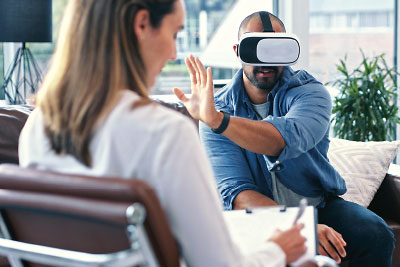Virtual reality (VR)–based exposure therapy is as effective as traditional exposure therapy for combat-related posttraumatic stress disorder (PTSD). Those with comorbid depression may particularly benefit most from its use, a study in Translational Psychiatry has found.
The study also revealed that certain genetic markers seemed to hint at whether a person with PTSD would benefit from additional treatment with the cognitive enhancer D-cycloserine (DCS).
“This study provides a step toward precision therapeutics for PTSD by demonstrating that comorbid MDD [major depressive disorder] and genetic markers may help guide treatment selection,” wrote Joan DiFede, Ph.D., a professor of psychology and psychiatry at Weill Cornell Medical College, and colleagues.
DiFede and colleagues enrolled 192 veterans and active-duty military aged 21 to 58 who had served in Iraq and/or Afghanistan and developed PTSD following combat trauma. Participants were divided into one of four treatment groups: virtual exposure therapy plus placebo, virtual exposure plus DCS, traditional exposure therapy plus placebo, or traditional exposure plus DCS. The researchers collected saliva samples from the participants to test for variants of the BDNF gene, which encodes a protein that is important for forming memories.
For traditional prolonged exposure, the participants were instructed to close their eyes, imagine the scene of their trauma, and repeatedly recount the trauma out loud in the present tense. For the VR-based approach, the participants recounted their trauma while wearing a headset that showed a virtual simulation of a scene related to the trauma that included audio, video, and tactile stimuli (for example, vibrations). Regardless of the assigned group, the participants received nine, 90-minute weekly exposure therapy sessions, which included two introductory sessions followed by seven sessions of exposure and processing discussion.
Starting with the third session, the participants took either a placebo or DCS pill 30 minutes before their session started.
Overall, participants in both groups showed significant symptom improvement after nine sessions, with scores on the Clinician Administered PTSD Scale or CAPS (range from 0 to 136) dropping by 20 points in the virtual exposure group and 21 points in the traditional exposure group. The researchers then compared patients based on depression status (54% of participants entered the study with comorbid depression) and found that those with depression had greater CAPS improvements with virtual versus traditional exposure therapy, whereas those without depression improved more under traditional exposure therapy.
“The novelty of using VR and being immersed in a virtual environment may be especially valuable or engaging to depressed patients, who exhibit altered reward processing and may therefore require greater stimulation to overcome negative experiences,” DiFede and colleagues wrote.
Among all participants, there was no difference in symptom improvement among those who took placebo versus DCS. However, among those who had a BDNF variant called Val66Met (about 32% of participants), DCS was associated with a larger improvement in CAPS compared with those who did not have the variant.
This study was supported by an award from the National Center for Advancing Translational Science. ■

